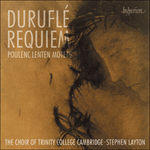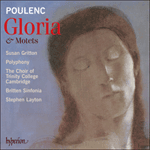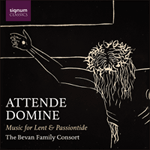
Welcome to Hyperion Records, a British classical label devoted to presenting high-quality recordings of music of all styles and from all periods from the twelfth century to the twenty-first.
Hyperion offers both CDs, and downloads in a number of formats. The site is also available in several languages.
Please use the dropdown buttons to set your preferred options, or use the checkbox to accept the defaults.

In 1921 Poulenc had decided that while the success of tiny pieces like the Mouvements perpétuels for piano and the song cycle Le bestiaire was gratifying, he nonetheless needed some formal teaching in order to make progress towards longer and perhaps more serious works. The teacher he chose, Charles Koechlin, turned out to be ideal. ‘His knowledge was prodigious,’ Poulenc later said, ‘but the most wonderful thing about him was the way he adapted himself to his pupil. He immediately sensed that, like many Latins, I was more of a harmonic than a contrapuntal writer, and so, at the same time as my counterpoint exercises, he made me set Bach chorale melodies in four parts. It was fascinating work and had a decisive influence on me. It’s thanks to this that I acquired the feeling for choral music.’
The surviving exercises he wrote, together with Koechlin’s suggestions and corrections, show the latter as a very open-minded teacher, allowing sharp, grating dissonances as long as they could be expressively validated, and a combination of suavity and abrasiveness was to be a hallmark of Poulenc’s vocal writing during the last twenty-five years of his life.
In each of these Lenten motets, he tends to support the beginning and end of his phrases with a consonant chord, but on the way from one to the other he takes us through some agonizing sounds, as well as some seductive ones. His responses to the Latin words are every bit as sensitive as in the mélodies that were taking on such profundity by the mid-1930s in cycles such as Tel jour telle nuit: witness, in the first motet, ‘Timor et tremor’, the heart-stopping drop in dynamics for the word ‘caligo’ (‘darkness’), and the ‘confounded’, chromatic descent in the soprano line on the final words, ultimately assuaged by a simple, plagal cadence; or the intense contrast in the second motet between the peaceful legato of ‘Vinea mea electa’ (marked ‘excessivement doux’ when it returns) and the bitter violence evoked by the discords on ‘crucifigeres’ and by the twin enunciations of the name ‘Barrabam’, after which the final tonic major chord comes over as harshly ironic. Contrasts of dynamics and texture also mark the last two motets. In ‘Tenebrae factae sunt’, the phrase ‘inclinato capite’ is set to a surprisingly stark, angular line, so that we can almost see the crown of thorns; and in the final motet, ‘Tristis est anima mea’, Christ’s abandonment by the disciples, set in almost operatic fashion, furnishes Poulenc with his ending, the ‘vobis’ of ‘immolari pro vobis’, possibly referring also to us, the audience?
The motets were first sung by their dedicatees, Les Petits Chanteurs à la Croix de Bois, on Good Friday, 7 April 1939. On Easter Day, Pope Pius XII, speaking urbi et orbi from the balcony of St Peter’s, denounced the violation of international treaties …
from notes by Roger Nichols © 2024
En 1921, malgré le succès encourageant de toutes petites pièces comme les Mouvements perpétuels pour piano et le cycle de mélodies Le bestiaire, Poulenc jugea qu’il avait néanmoins besoin d’un enseignement plus formel afin d’avancer vers des œuvres plus longues et peut-être plus sérieuses. Le professeur qu’il choisit, Charles Koechlin, s’avéra idéal. «Sa science était prodigieuse», dira-t-il plus tard, «mais ce qu’il y avait de plus prodigieux chez lui, c’était son sens de l’adaptation à l’élève. Ayant de suite senti que, comme beaucoup de Latins, j’étais plus harmoniste que contrapuntiste, il me fit, parallèlement aux devoirs de contrepoint, réaliser en quatre parties des thèmes de choral de Bach. Ce travail, qui me passionnait, a eu une influence décisive sur moi. C’est grâce à cela que j’ai acquis le sens de la musique chorale.»
Les exercices écrits par Poulenc qui nous sont parvenus, avec les suggestions et les corrections de Koechlin, montrent que ce dernier était un professeur à l’esprit très ouvert, autorisant des dissonances fortes et discordantes du moment qu’on pouvait en prouver le bien fondé de façon expressive, et un mélange de suavité et de rudesse allait devenir une caractéristique de l’écriture vocale de Poulenc au cours des vingt-cinq dernières années de sa vie.
Dans chacun de ces motets de carême, il a tendance à soutenir le début et la fin de ses phrases avec un accord harmonieux, mais entre les deux il nous fait passer par des sons déchirants, ainsi que par quelques sonorités séduisantes. Ses réponses aux mots latins sont tout aussi sensibles que dans les mélodies si profondes du milieu des années 1930 dans des cycles comme Tel jour telle nuit: par exemple, dans le premier motet, «Timor et tremor», l’incroyable baisse de dynamique pour le mot «caligo» («obscurité») et la descente chromatique «déconcertante» à la ligne de soprano sur les paroles finales, qui s’apaise finalement sur une simple cadence plagale; ou l’intense contraste dans le deuxième motet entre le paisible legato de «Vinea mea electa» (marqué «excessivement doux» lorsqu’il revient) et la féroce violence évoquée par les dissonances sur «crucifigeres» et par les doubles énonciations du nom «Barrabam», après quoi le dernier accord à la tonique majeure donne l’impression d’une ironie sévère. Des contrastes de dynamique et de texture marquent aussi les deux derniers motets. Dans «Tenebrae factae sunt», la phrase «inclinato capite» est chantée sur une ligne angulaire d’une étrange austérité, si bien que l’on peut presque voir la couronne d’épines; et dans le dernier motet, «Tristis est anima mea», l’abandon du Christ par les disciples, mis en musique un peu comme un opéra, fournit à Poulenc son dénouement, le «vobis» d’«immolari pro vobis», faisant peut-être aussi référence à nous, l’auditoire.
Les motets furent chantés pour la première fois par leurs dédicataires, Les Petits Chanteurs à la Croix de Bois, le Vendredi Saint, 7 avril 1939. Le jour de Pâques, le pape Pie XII, parlant urbi et orbi du balcon de Saint-Pierre, dénonçait la violation des traités internationaux …
extrait des notes rédigées par Roger Nichols © 2024
Français: Marie-Stella Pâris
1921 war Poulenc zu dem Schluss gekommen, dass der Erfolg von kleinen Stücken wie den Mouvements perpétuels für Klavier und dem Liederzyklus Le bestiaire zwar erfreulich war, er aber dennoch formalen Unterricht benötigte, um längere und vielleicht ernsthaftere Werke angehen zu können. Der Lehrer, den er wählte, Charles Koechlin, erwies sich als ideal. „Sein Wissen war gewaltig“, bemerkte Poulenc später, „aber das Beste an ihm war die Art und Weise, mit der er sich auf seine Schüler einstellte. Er spürte sofort, dass ich, wie viele Südländer, eher ein Harmoniker als ein Kontrapunktiker war, und er ließ mich parallel zu meinen Kontrapunktübungen Choral-Themen von Bach vierstimmig aussetzen. Das war sowohl faszinierend als auch sehr prägend für mich und hat mir ein Gefühl für Chormusik gegeben.“
Poulencs Aufzeichnungen dieser Übungen, die überliefert sind und Koechlins Vorschläge und Korrekturen enthalten, zeigen diesen als einen sehr aufgeschlossenen Lehrer, der scharfe, knirschende Dissonanzen zuließ, solange sie ausdrucksvoll zur Geltung gebracht werden konnten, und eine Kombination aus Sanftheit und Schärfe sollte in den letzten 25 Jahren seines Lebens ein Markenzeichen von Poulencs Vokalwerk sein.
In den Bußmotetten neigt er jeweils dazu, den Anfang und das Ende seiner Phrasen mit einem konsonanten Akkord zu untermauern, dazwischen jedoch führt er uns durch einige quälende, aber auch verführerische Klänge. Seine Reaktionen auf die lateinischen Texte sind ebenso feinfühlig wie in den Melodien, die Mitte der 1930er Jahre in Zyklen wie Tel jour telle nuit eine derartige Tiefgründigkeit erreichten. So findet in der ersten Motette, „Timor et tremor“, ein atemberaubender Dynamikwechsel bei dem Wort „caligo“ („Dunkelheit“) statt und der „verwirrte“, chromatische Abstieg in der Sopranstimme bei den letzten Worten wird schließlich durch eine schlichte plagale Kadenz abgemildert. Weitere Beispiele sind der starke Kontrast in der zweiten Motette zwischen dem friedlichen Legato von „Vinea mea electa“ (das bei seiner Wiederholung mit „excessivement doux“ bezeichnet ist) und der bitteren Gewalt, die durch die Dissonanzen bei „crucifigeres“ und durch die zweifache Nennung des Namens „Barrabam“ hervorgerufen wird, wonach der abschließende Durakkord in der Grundtonart als harsche Ironie erscheint. Kontraste in Dynamik und Textur kennzeichnen auch die beiden letzten Motetten. In „Tenebrae factae sunt“ wird die Phrase „inclinato capite“ auf eine überraschend strenge, kantige Linie gesetzt, so dass man fast die Dornenkrone sehen kann; und in der letzten, beinahe opernhaft vertonten Motette, „Tristis est anima mea“—Christi Verlassenheit von seinen Jüngern—komponiert Poulenc einen Schluss, in dem sich das „vobis“ von „immolari pro vobis“, vielleicht auch auf uns, das Publikum, bezieht?
Die Motetten wurden erstmals von ihren Widmungsträgern, Les Petits Chanteurs à la Croix de Bois, am Karfreitag, dem 7 April 1939, gesungen. Am Ostersonntag prangerte Papst Pius XII. in seinem Segen Urbi et Orbi von der Loggia des Petersdoms aus die Verletzung internationaler Verträge an …
aus dem Begleittext von Roger Nichols © 2024
Deutsch: Viola Scheffel
 Duruflé: Requiem; Poulenc: Lenten Motets Duruflé: Requiem; Poulenc: Lenten MotetsA superlative account of Duruflé’s evergreen Requiem from the Trinity College Cambridge forces and their illustrious Director of Music Stephen Layton. With the addition of Poulenc’s austerely beautiful motets ‘pour un temps de pénitence’, this rel ...» More |
 Poulenc: Gloria & Motets Poulenc: Gloria & MotetsStephen Layton and Polyphony continue to blaze a trail as great interpreters and dazzling performers of a wide range of choral music. Here they turn to some of the most bewitching and unusual, yet well-loved, choral works of the twentieth century. ...» More |
 Poulenc: Gloria & other sacred music Poulenc: Gloria & other sacred musicCollegium's recording offers an extensive selection of Poulenc's sacred choral music with the Gloria as centrepiece.» More |
 Attende Domine Attende Domine“Recording an album with the family is always moving, but this one was especially so because of the theme of the music. Like previous albums, this one contains well-worn family favourites beside newly discovered or unrecorded rarities, thanks to o ...» More |

